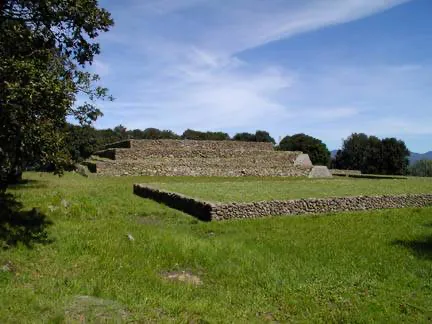Huamango, now known as the archaeological site of San Miguel Ixtapan, was once a flourishing pre-Hispanic city. It is located in the State of Mexico, near the modern town of Atlacomulco. The site is notable for its unique architectural style and the mysterious civilization that built it. Huamango offers a glimpse into the complex urban and cultural development of the region before the arrival of the Spanish conquistadors.
Get your dose of History via Email
Historical Background of Huamango
Archaeologists discovered Huamango in the 20th century, revealing its historical significance. The site was built by a civilization that thrived in the Postclassic period, around 900-1200 AD. The identity of the builders remains a topic of research, but they were likely a group influenced by the Toltecs and other regional powers. Huamango was a regional center, possibly involved in trade networks and cultural exchanges.
After its peak, the city’s importance declined, and it was eventually abandoned. The reasons for this decline are still under investigation. Later, the site was inhabited by the Aztecs, who left their own mark on the area. Huamango was not the scene of any known historical battles or events, but it was an important cultural and economic hub in its time.
The site was first studied by Mexican archaeologist José García Payón. He conducted initial excavations and research, bringing Huamango’s significance to light. Since then, various archaeological projects have explored the site, uncovering its structures and artifacts.
While Huamango was not a major political capital, its structures and artifacts suggest a society with complex social and religious practices. The site includes pyramids, plazas, and residential areas, indicating a well-organized urban plan. The presence of ball courts suggests that the Mesoamerican ballgame was an important aspect of the culture.
Today, Huamango is recognized for its historical value. It provides insights into the lesser-known cultures of pre-Hispanic Mexico. The site is a testament to the diversity and richness of Mesoamerican civilizations before European contact.
About Huamango
Huamango’s architecture is distinctive, with buildings constructed from volcanic stone. The site includes several pyramids, a ball court, and residential complexes. The main pyramid is particularly impressive, featuring a large staircase and a platform on top, likely used for ceremonial purposes.
The construction techniques of Huamango reflect the skills of its builders. They used a combination of stone masonry and adobe, a testament to their architectural knowledge. The layout of the city suggests a high degree of urban planning, with a clear central area and surrounding residential zones.
One of the architectural highlights of Huamango is the ball court. It is a key feature of many Mesoamerican sites and was used for the ballgame, which had religious and social significance. The court at Huamango is well-preserved, providing valuable information about the game and its role in society.
The building materials used at Huamango include local stone, which was expertly carved and fitted. The use of adobe for some structures also indicates an adaptation to the local environment and resources. The combination of these materials showcases the ingenuity of the site’s inhabitants.
Overall, Huamango’s architecture offers a window into the technological and artistic capabilities of its builders. The site’s preservation allows for ongoing study and appreciation of its construction methods and architectural beauty.
Theories and Interpretations
Several theories exist about Huamango’s purpose and the civilization that built it. Some scholars suggest it was a religious center, while others believe it was primarily a trade hub. The true function of Huamango remains a subject of debate among historians and archaeologists.
The mysteries of Huamango include the identity of its builders. While there is evidence of Toltec influence, the specific ethnic group or groups responsible for its construction are not definitively known. This has led to various interpretations based on the artifacts and architectural styles found at the site.
Historians have matched aspects of Huamango to historical records from the region. These comparisons have helped to piece together a partial history of the site. However, gaps in the record leave room for interpretation and further research.
Dating of the site has been carried out using methods such as stratigraphy and radiocarbon dating. These techniques have helped establish a timeline for Huamango’s occupation and use. The results suggest that the site was most active during the Postclassic period.
Overall, Huamango is a complex site that has sparked numerous theories and interpretations. Its study contributes to our understanding of Mesoamerican history and the diverse cultures that existed before the Spanish conquest.
At a glance
Country: Mexico
Civilization: The Toltecs
Age: Postclassic period, approximately 900-1200 AD

